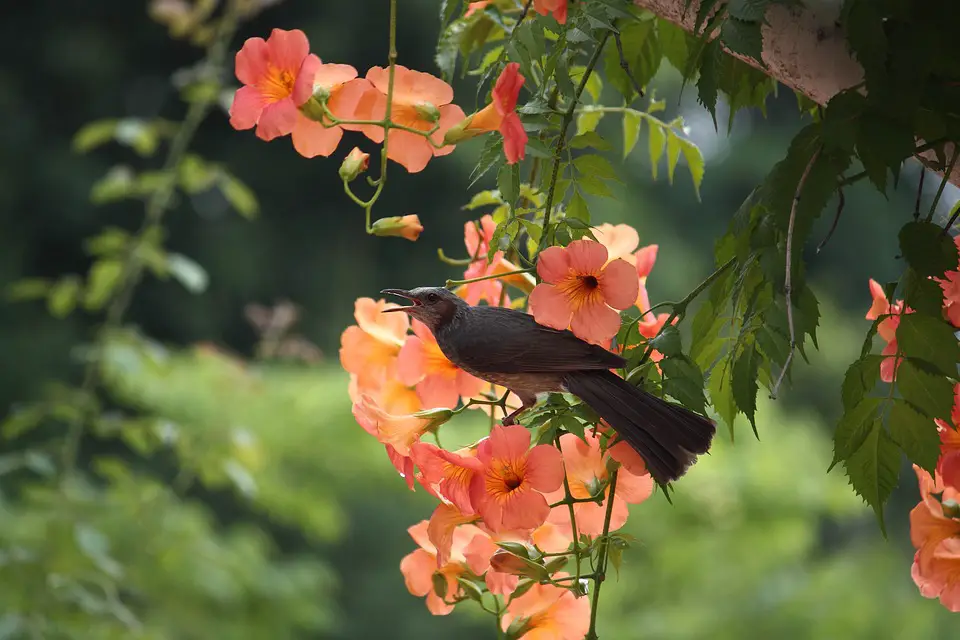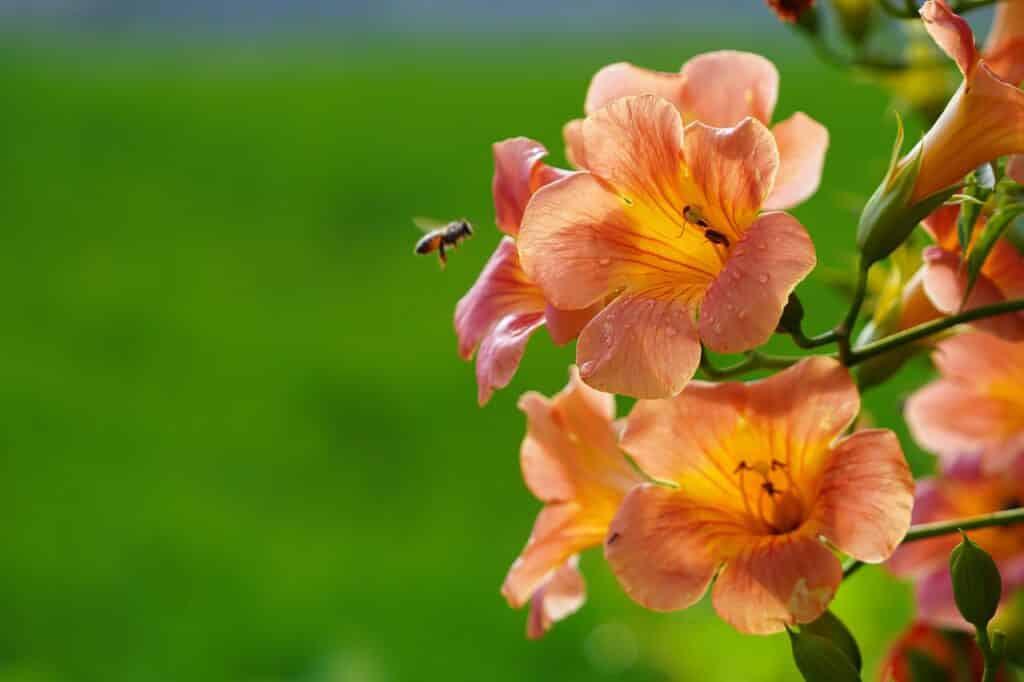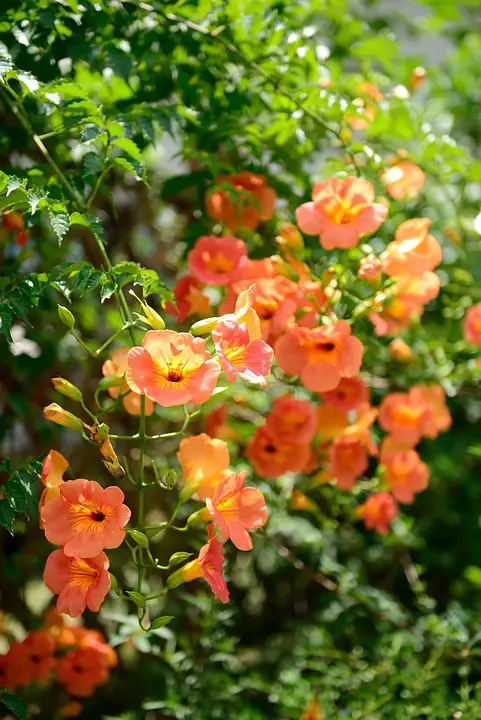The hummingbird vine, also known as campsis radicans is a unique and beautiful flowering plant. It has around 3 inches long trumpet-shaped flowers, with multiple colors ranging from salmon-red to yellow. Commonly known as trumpet creeper, it grows in USDA hardiness zone 4 to 10.

Besides, having long, beautiful flowers with multiple color shades, this creeper plant is famous for attracting hummingbirds and bees. If you want to attract such a beautiful gift from nature then you need to learn how to plant hummingbird vine seeds.
Hummingbird plants
The hummingbird vines are usually grown for their beautiful flowers having multiple colors. The people who love nature and like the flowers through which they can fill the garden quickly, they opt for this plant.
Moreover, these plants spread a lot in height and width. This quality makes them preferred over the other creeping plants. Many people like them because it is easy to take care of these plants, and especially these are easy to propagate and grow more from the existing ones.
Do hummingbirds eat trumpet vine?
Besides having beautiful flowers and colors, this plant mainly attracts hummingbirds and bees. Hummingbirds are one of the smallest birds of nature and the most beautiful creature. So, they plant these vines to attract them and get the benefits of pollination from the bees.
Why Grow Hummingbird Vine Plants?

Firstly, this plant will help in the pollination of itself and as well as for other fruit and vegetable plants in the garden. Specifically, because it attracts bees. A lot of the time fruiting, and ornamental plants don’t perform well because of poor pollination in the garden.
Secondly, the growth of these hummingbird vines is excellent. It can grow up to 40 feet high and 5 to 6 feet wide. This makes it one of the preferable creeping vines because it covers the ground/area very well.
Also, this plant is easy to take off. Once established you need little or no care for this plant to survive effectively. You can spread this plant by providing its seeds to friends or family because its seeds are easy to harvest and easy to make suitable for sowing and growing.
Best Hummingbird Plants
There are two main vines which are usually known as hummingbird vines. These are Cypress Vines and Trumpet Vines.
Cypress vines are climbing vines. These should be placed near the walls or the fences. These types of vines can grow much larger. You need to prune these plants to keep them in proper shape. When pruned it looks beautiful. You can prune it after the flowers die. Water them in the dry seasons.
On the other hand, Trumpet vines are known for their trumpet-shaped flowers with multiple colors. These vines are creepers as well as a climber. When there is support, these vines can go up to three stories high. These attract a lot of hummingbirds, bees, and butterflies.
These vines are famous not for their flowers and colors only but also for their ability to grow rapidly. If you want to make a fence or want to get the ground covered, try this.
How to Plant Hummingbird Vine from Seeds
As they belong to the same family of hummingbird vines, both of their types are treated the same in the sense of sowing, planting, and growing. So you don’t need to worry about varieties that might have different procedures to follow.
How do you propagate hummingbird vines?
These vines can be propagated from other means but through seeds, there is more chance of successful plantation and growth of these vines.
Getting the trumpet vine seed pods
Do trumpet vines have seed pods?
Hummingbird vines produce pods that have ornamental value in the bloom season. These pods contain the seeds of hummingbird vines. These pods are around 5 cm long. The seeds of the vines are flat, round brown discs.
How to propagate trumpet vine from seed pods
We mentioned the above information so you can easily get the seeds of hummingbird vines if it is available near you. You should pick the pods when they are dry and brown. Also, take care in picking, it is recommended that you use gloves because they might cause any skin problems.
Hummingbird vine seeds
When picked, get the seeds out and place them on a towel or paper to dry them completely before you plant. You can also get the seeds from the gardening stores or the nurseries available near your living area if you don’t have any plant of hummingbird vines. You can get seeds online also.
Cold Stratification of Hummingbird Vines Seeds
Seeds germinate more rapidly and successfully when they undergo the process of cold stratification. In this process, you need to soak the seeds in a bowl of water for around 24 hours. After that get the sealed plastics and place the seeds inside with a soil mixture of organic material.
Put it in the refrigerator for about 2 months. If you are living in warm areas, then you can sow the seeds right after picking and drying. This chilling period will be passed in the soil. But if you are from the area of cold winters, then you need this cold stratification and sow the seeds after the last frost has passed
Sowing the Hummingbird vine seeds
Now, as the seeds are ready to be sown, you need to get the right pot and the soil mixture. Use good garden soil which is mixed with organic composted material to make sure it gets enough nutrients. Moisten the soil before sowing the seeds.
Now soil and pot are ready, you can sow the seeds. Sow the seeds on the upper layer of the soil. Keep this upper layer of soil loosened. Also, add a little layer like sprinkles of soil after sowing the seeds. Water the seeds after you have sown them.
Water the seeds with care. The pot should be well-drained. Excess water might result in complete loss. It may result in the dampening of seeds or roots rot. So, handle this aspect with care.
Now seeds have been sown, you can put the pot in a warmer place and consistently add a moderate amount of water to it. You can wrap the pot in plastic to enhance germination. If it is covered with plastic, place it for one hour in the sun to get rid of excess moisture. Remember to remove the plastic at the time you place it in the sunlight.
These plants spread a lot in height and width. This quality makes them preferred over the other creeping plants.
Trumpet Vines Seedlings
Many people like them because it is easy to take care of these plants, and especially these are easy to propagate and grow more from the seedlings.
Now as the plants have germinated and stems have been established, you can transplant them to the final place. Simply select the location which has good sun exposure because the vines grow well in sun exposure. If you want to provide any support to the plant, plant it near the wall or a fence or build support.
Soil Preparation For Hummingbird Vines
Till the place where you are going to plant the hummingbird vines. Add the organic material to the soil. Get any weeds out from that place. Get the holes ready. Keep the distance of 36 to 48 inches between the plants. Plant the seedlings in the holes so that the root ball is completely covered.
After the plantation is done add mulch along the sides of the plants. It will keep up with the required moisture. It is necessary to maintain good moisture in the first two growing seasons. Then you can reduce the frequency of the watering according to the weather conditions also.
Taking Care of Hummingbird Vines Plants

Taking care of hummingbird vines is easy. Once established then you don’t need to worry about it.
Watering hummingbird Vines
Watering is required on regular basis in the early two to three growing seasons. Then you can add water according to weather conditions. Always keep in mind that you have to keep the moisture intact. Don’t overwater the plant, which might cause problems.
Use of Fertilizers for Hummingbird Vines
What do I feed my trumpet vine?
The use of fertilizers can prove beneficial for trumpet vines. You can apply one cup of 5-10-5 granular fertilizer every spring.
Pruning of Hummingbird Vines
Pruning is required for these vines. They can grow very large and can endanger the growth of other plants and vegetables present in the garden. Some experts have suggested growing it near the concrete so that it cannot grow rapidly, and its seeds cannot germinate any further.
On the other hand, pruning is necessary for these plants. As mentioned earlier these can grow very high in sense of height. Pruning will keep them in a shape and will also save the surrounding trees and vegetables. Pruning will make the vines stronger and resistant to diseases and pests.
So, in a nutshell, you can say these vines will not only be great addition to the garden, but also a great plant that will be able to supply its offspring very easily.
Also, these vines will keep the garden full and will cover all the areas which you think cannot be used for any other purpose.
ALSO, READ
How to Plant Narcissus Bulbs Indoor
References
https://www.gardeningknowhow.com/ornamental/vines/trumpet-vine/germinating-trumpet-vine-seeds.htm
https://homeguides.sfgate.com/plant-grow-hummingbird-vines-39556.html
